Best in-ear monitors 2025: IEMs for stage and studio
Our expert guide to the best in-ear monitors we've testedfor practice, performance and production, no matter your budget
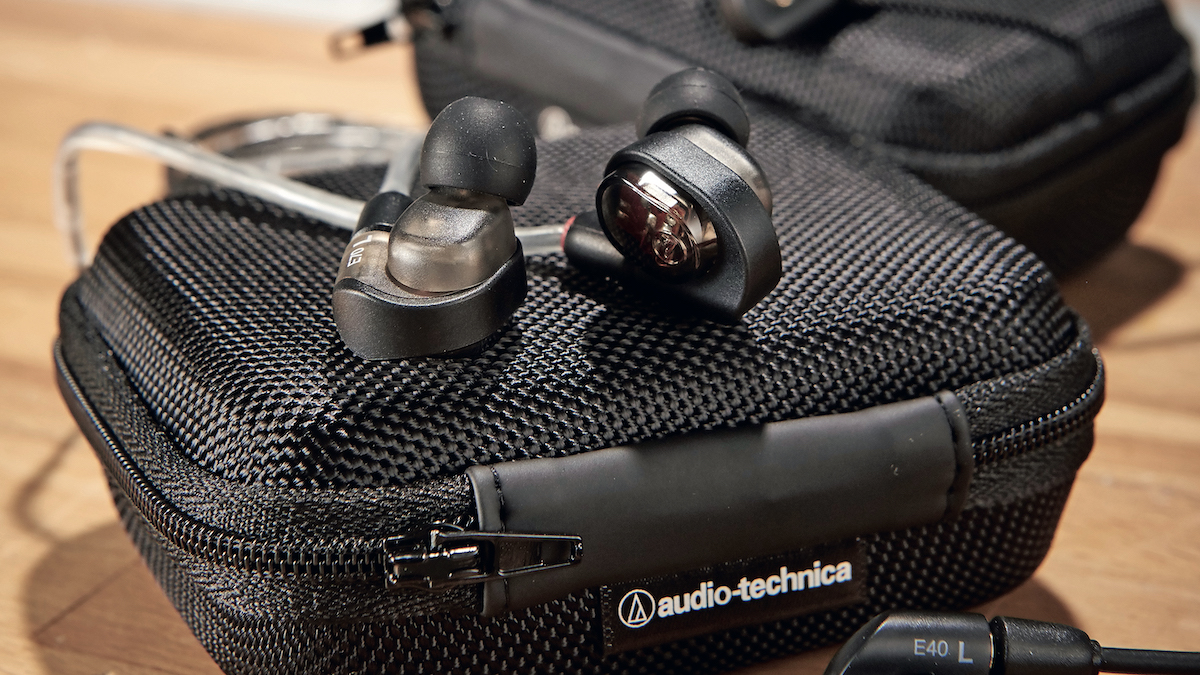
Adding a pair of the best in-ear monitors (IEMs) into your set-up is a confident step for any musician that has reached a certain stage in their performing journey. Whether you’re part of a band, a solo artist or front-of-house engineer, it signifies a commitment to taking things seriously and a desire to ensure that your fans hear the music exactly as you intend it. In short, in-ears are a powerful next-step to having more control over your sound and your performance.
In-ear monitors are designed with two purposes in mind: they deliver clear, neutral sound directly to your ears from within; and isolate your ears from harmful stage or studio volumes without. With in-ears, there’s no more straining to hear your monitor wedge against all the competing sounds on stage; backing tracks, band leader communications, metronomes, or just your own voice, are delivered clearly and without competition. IEMs offer practical advantages unrivalled by house monitor wedges or consumer-grade wearables. And they aren’t all as expensive as you may have previously thought, either.
Here, I’ve collected what I consider to be the best in-ear monitors available on the market today, across a variety of budgets, specifications and use cases. All are generic-fit, meaning you can wear them straight after purchase (as opposed to getting moulds of your ear canals made for custom-fit IEMs).
Right now, my top pick is the Shure SE846 Pro. If your budget will stretch, I cannot fault the pristine audio reproduction of these IEMs. I love the fit, too. To enter the world of Shure for less, my budget recommendation right now is the Shure SE215 Pro.
If you’re ready to say goodbye to a lifetime of futility requesting “more in the monitors, please”, read on to check out my picks for the best IEMs. Want to know more? There’s a smorgasbord of buyer’s advice, FAQs and key terms explained down below.
Our top picks
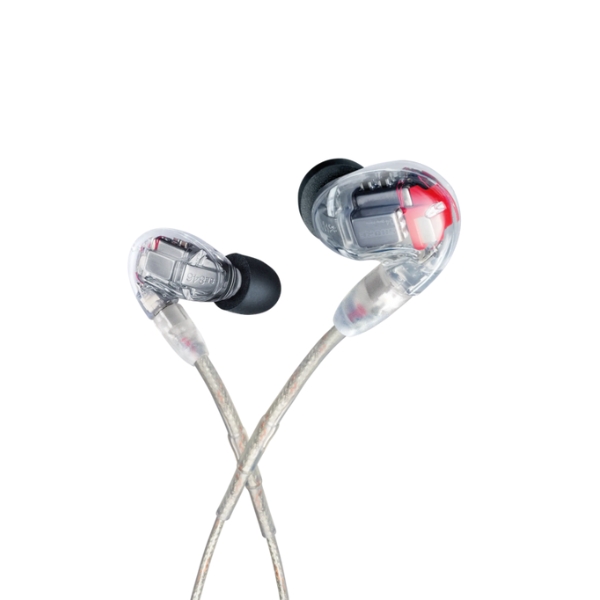
They may not look like much but these in-ear monitors absolutely blew us away with their combination of audiophile-level sound quality and fantastic isolation properties.
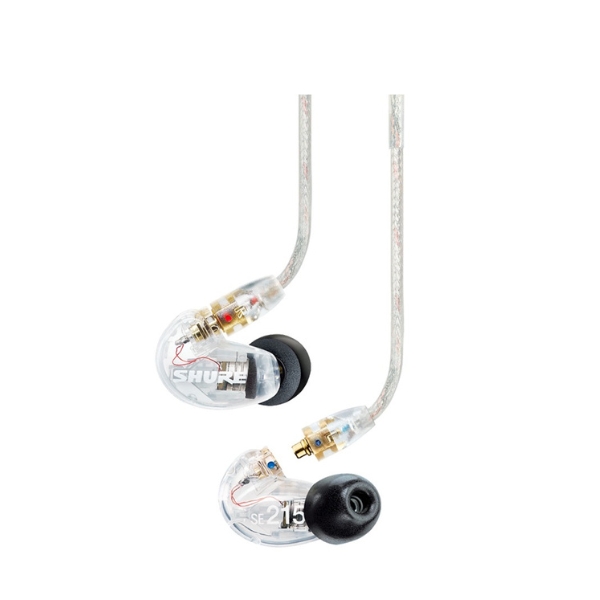
Arguably one of the best budget in-ear monitors you can buy, Shure's SE215 Pro is the perfect entryway to the world of professional monitoring on stage.
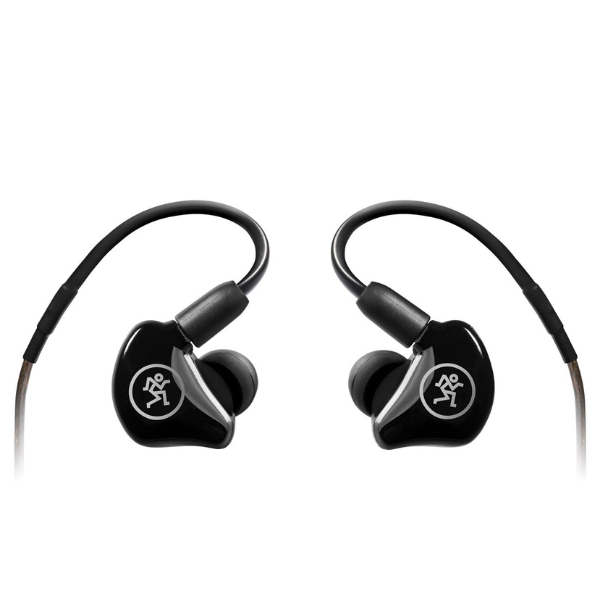
One of the significant factors in your choice of in-ear monitor is the amount of drivers, so two is always better than one! The Mackie MP-220 offer dual drivers for a fantastic price.
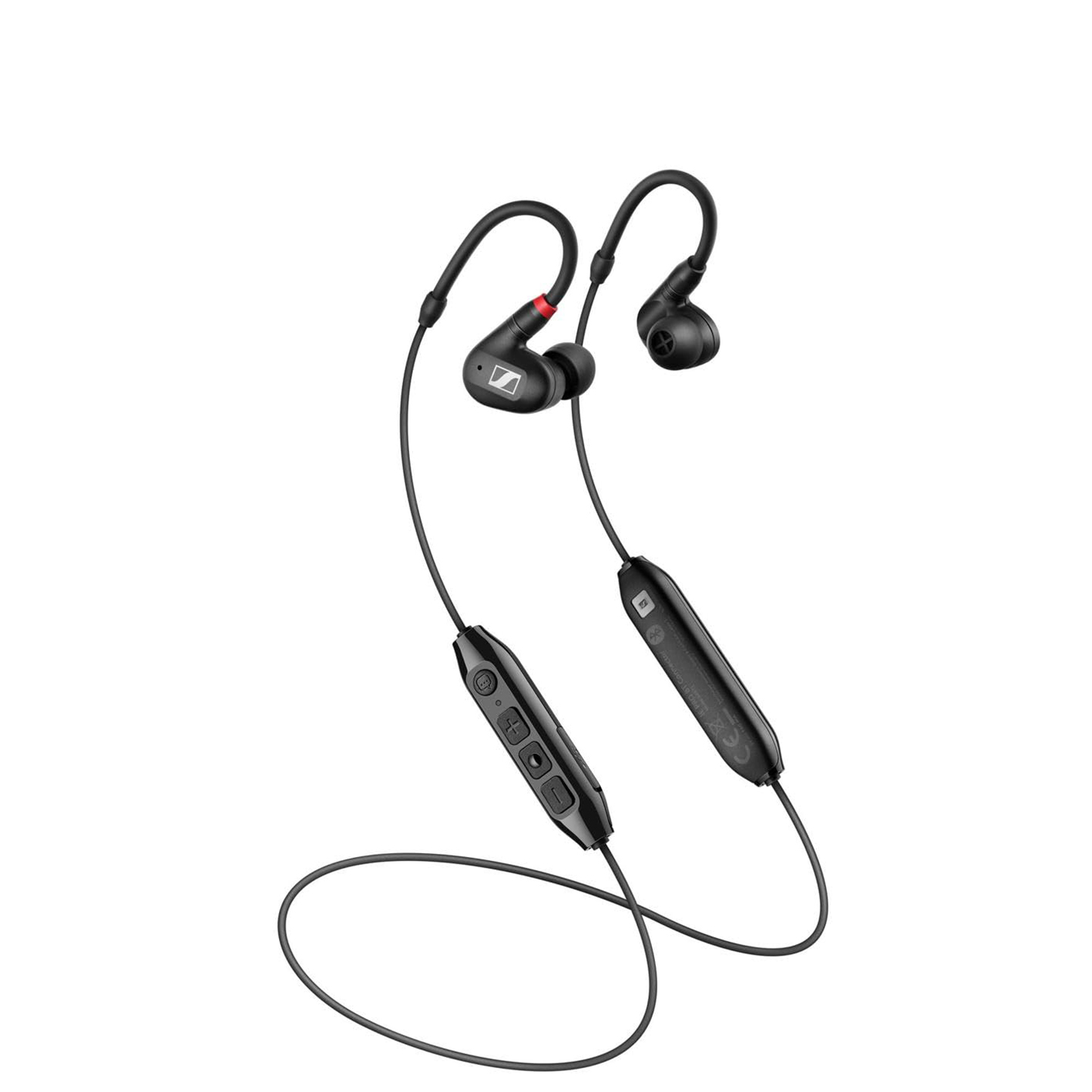
A fantastic set of budget-price IEMs, made all the more fantastic for their approach to in-ear comfort. Lightweight design and ergonomic shape mean you can wear these for hours.

Sitting nicely in the midrange, the Audio Technica ATH-E70 provides the perfect step up from your first set of in-ear monitors thanks to three powerful drivers.

A set designed specifically for critical listening, hence a godsend set for the live sound engineers amongst us. Broad frequency range and representative sculpting make for a powerful set of pure professional IEMs.
Best overall
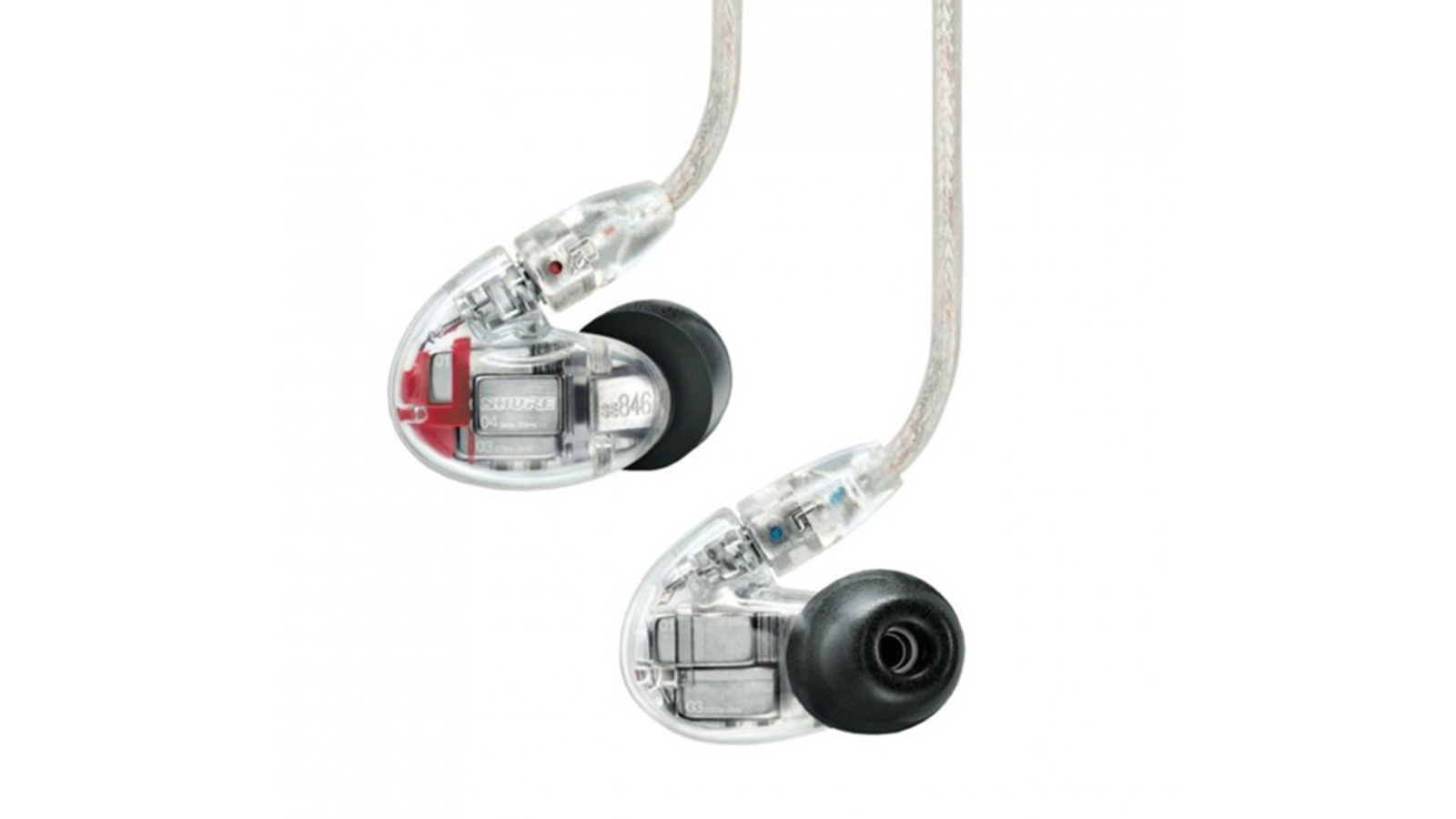
Specifications
Reasons to buy
Reasons to avoid
✅ Buy if you want the best sound reproduction: We simply cannot fault the audio quality with these IEMs. If you have the budget, there's no better choice.
❌ Avoid if looks are important to you: Brilliant in-ears, yes, but their styling is pretty pedestrian.
Build quality ★★★★½
Comfort ★★★★½
Performance ★★★★★
Overall ★★★★½
Overview: In some senses, the Shure SE846 Pro is the archetypal in-ear monitor. When you think about IEMs, you imagine clear plastic housings with various electrical gubbins ensconced safely within – a shrimp-like form, jettisoning cables forward and out to loop round the ear and down the back. You imagine these. Why is it, then, that these IEMs have come to represent an entire industry of industry-standard monitoring tech? Well, the same reason it’s topped my list of the best in-ear monitors.
Build quality: The Shure SE846 Pro is an exceedingly well-designed piece of auditory machinery. So much is crammed into that miniscule frame, and none of it feels at risk; these are hardy (and somewhat bouncy) enough to avoid the cracks and crushes many cheap imitators are likely to suffer from on a busy stage.
Comfort: These IEMs are remarkably comfortable to wear, too, even if they take a little practice to get settled properly in-ear. There are various sizes and forms of tip available for you to try, so you can get the proper seal your ears demand. The front-facing cables make it very easy to loop and nestle the wires behind your ears, for a snug and taut fit that doesn’t reduce your mobility too much.
Performance: In terms of sound reproduction, you can see why the audiophile crowd gravitates towards the Shure SE846 Pro. A four-driver set-up means capable control of the entire frequency range, with a dedicated ‘subwoofer’-esque bass driver for better low-end performance.
For the tinkerers, there are three interchangeable filter inserts supplied with the SE846 Pro, facilitating a balanced response, extra warmth and extra brightness in turn; some disassembly is required to make the most of these, though. Crucially for the live musicians amongst us, they also offer up to 37dB of sound attenuation, making them aggressively safe for concert applications as well as aggressively excellent.
Verdict: Basically, these blew me away. And why wouldn’t they? They’re top-flight generic-fit IEMs, with endless customisability and applicability. Couple that with their predictability, quality build and unparalleled performance, and you have an all-time great pair of in-ears for both the gigging musician and the studio engineer.

"Delivering outstanding detail and clarity across the board, these top-of-the-line pro IEM's are some of the most capable earphones we’ve heard."
Read more: Shure SE846 Pro review
Best budget
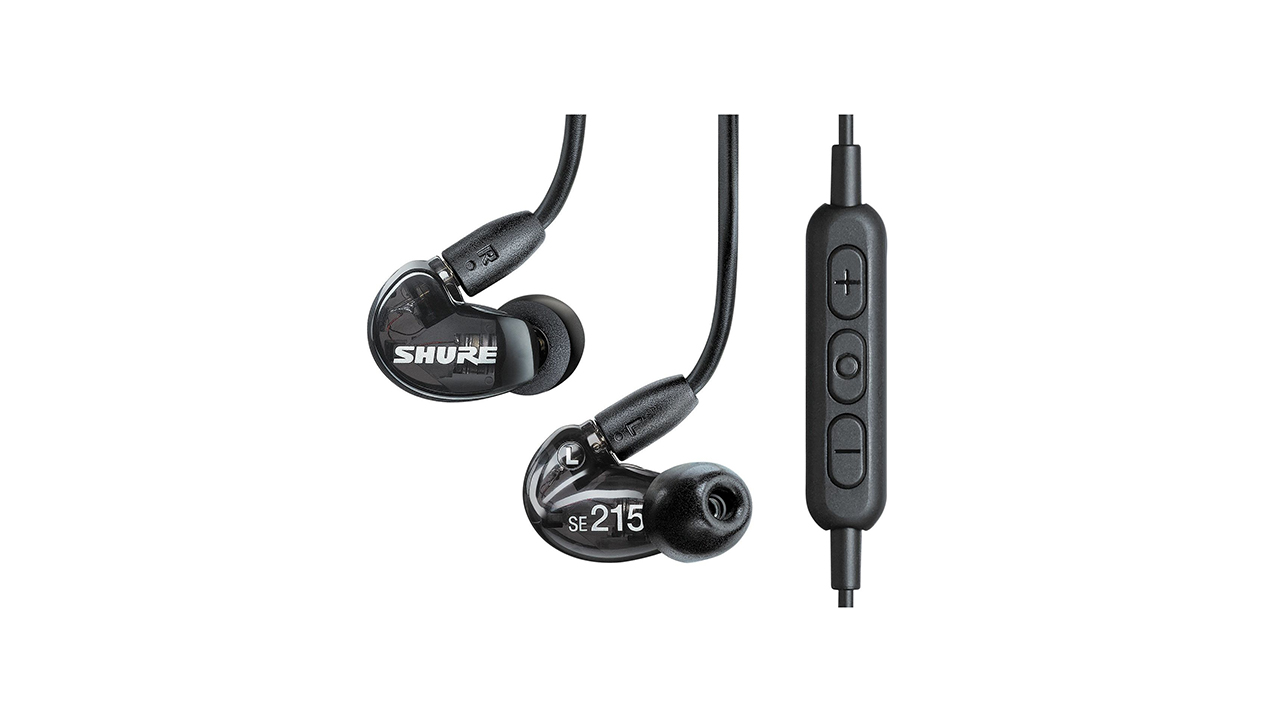
Specifications
Reasons to buy
Reasons to avoid
✅ Buy if you're stepping into the world of IEMs on a budget: For music performance and personal music listening you can't go wrong with this reliable pair of Shures.
❌ Avoid if sound is important to you: You won't find audiophile levels of sound reproduction here.
Build quality ★★★★½
Comfort ★★★★☆
Performance ★★★★½
Overall ★★★★½
Overview: Shure may have topped this list with some primo professional in-ears, but the brand is also king in the entry level – as demonstrated handily by these: the Shure SE215 Pro in-ear monitors. These affordable little numbers take some cues from their more expensive sibling’s greater successes, while making for a wallet-friendly set of powerful on-stage friends. They're currently at the top of our best budget in-ear monitors list, too.
Build quality: Being on the cheaper end of the spectrum, it will surprise no-one that the Shure SE215 Pro isn’t the most robust set of in-ears that money can buy. They aren’t cheap-feeling, but they are a little more likely to succumb to stage-borne antics than other, pricier units.
This isn’t a demerit for these in-ears though; far from it. Their incredible performance for their price makes replacing them an easy pill to swallow – and damaging them much less of a worry overall. Besides, they retain the detachable cable design of their more expensive counterparts, a feature missing from many competitor products in the same price bracket.
Comfort: I wouldn’t volunteer to wear the SE215 Pro for particularly extensive lengths of time, but these in-ears are by no means uncomfortable. They’re easy enough to set and forget, and with a variety of foam and silicone tips to pick between, there’s enough customisability to cater to most people’s personal ear-comfort inclinations.
Performance: The SE215 Pro breaks from Shure’s tenfold-priced SE846 Pro by limiting itself to a single high-definition driver in each earpiece. Naturally, you lose a lot of the control and presence that other, more expensive IEMs enjoy by virtue of clever division of duties across multiple drivers – but this one driver does a great deal of heavy lifting, particularly for the retail price of these in-ears.
Further, the SE215 Pro does a fantastic job of attenuating external noise, giving you some decent passive sound isolation for a better experience in louder environments. Again, this isn’t as complete or controlled as more expensive IEMs, but for the price there are absolutely no complaints here.
Verdict: As a budget entry to the world of IEMs, the Shure SE215 Pros serve admirably. The balance of sound quality, build quality and price is respectable, to say the least – and they more than deliver in day-to-day usage as well as on-stage. Spend a little, get a lot!

"The Shure SE215 Pro in-ear monitors are a brilliant budget option, whether you’re looking for your first ever monitoring system, a pair of backup IEM’s or just some killer multi-use earphones. For under $110/£100, Shure has nailed the value-for-money factor, offering great ambient noise cancelling, a decent frequency range and surprising levels of in-ear comfort."
Read more: Shure SE215 Pro review
Best dual driver
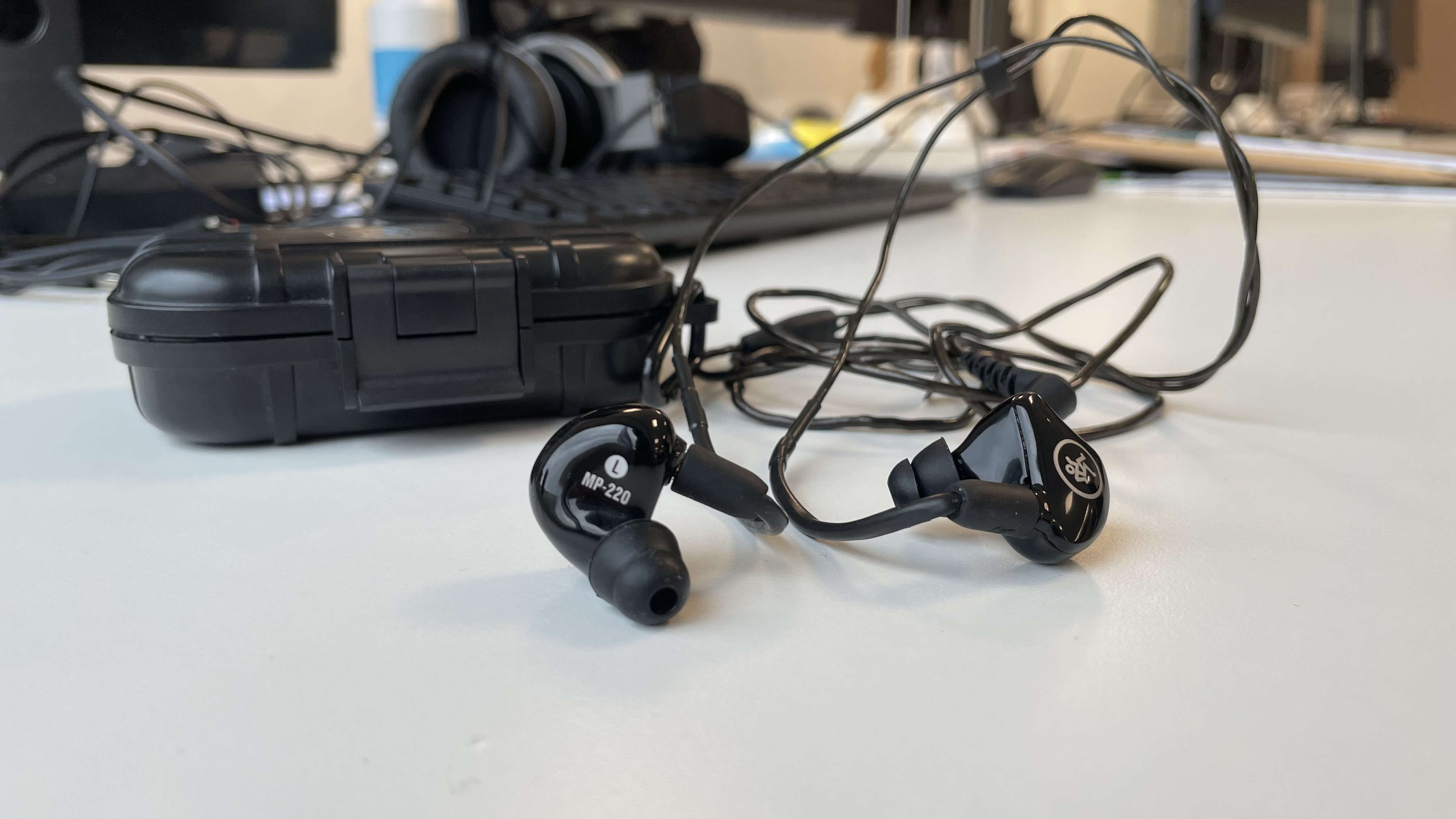
Specifications
Reasons to buy
Reasons to avoid
✅ Buy if you want dual drivers on a budget: You really will notice the difference when making the jump from single driver IEMs.
❌ Avoid if you have smaller ears: Some of our testers found these to be a little too snug.
Build quality ★★★★☆
Comfort ★★★★½
Performance ★★★★☆
Overall ★★★★☆
Overview: When choosing a set of in-ear monitors, the number of drivers is a significant metric to consider. In-ears with multiple drivers are better performers across the frequency spectrum, being able to delegate certain frequency bands to different drivers in different places. Most budget models leave the burden of reproducing everything across the spectrum to a single driver – but not the Mackie MP-220. This is a dual-driver set of in-ear monitors, and arguably the ideal first 'proper' set of IEMs for any budding performer.
Build quality: Mackie isn’t setting the world on fire with its in-ear design here; the MP-220 is capably put-together for its sub-$150/£100 price point, and reassuringly sturdy enough for you to trust it with a tour or two. A neat touch is the plastic hard case it ships with, which takes after the plastic tough-case mic boxes that frequently accompany artists on the road.
Comfort: These in-ears are a breeze to get in place – and when fitted securely, there was no unwanted movement or discomfort experienced in use. Indeed, they survived a whole set’s worth of shameless headbanging with relative ease, only needing some minor adjustment at points. You might not forget you’re wearing them, but you can be sure that they’ll sit happily when you place them.
Performance: The dual drivers’ collective performance is a real credit to Mackie’s engineering nous here. Even at this low price point, these drivers are pulling the weight of mid-weight IEMs, with crisp highs and robust lows in turn. That said, fit does seem to play a large role in the performance you get out of them. With the earpiece pushed-in a little far, we found the bass to be overwhelming, and the overall clarity compromised – and vice versa when not pushed in far enough. With the right silicone tip, though, you’ll be right as rain.
Verdict: The Mackie MP-220 is an excellent set of in-ear monitors – and especially so for the price. It’s hard to find equivalent dual-driver performance at this level; add this to the bomb-proof travel case, and you have a decent set of gigging in-ears.

"For budding performers, audiophiles or those who don’t want to spend the earth, the Mackie MP-220 in-ear monitors are among the best. When most budget in-ears only offer one driver, the two-driver approach from Mackie is a welcome one - and puts the MP-220’s a league above some of their budget rivals."
Read more: Mackie MP220 review
Best for comfort
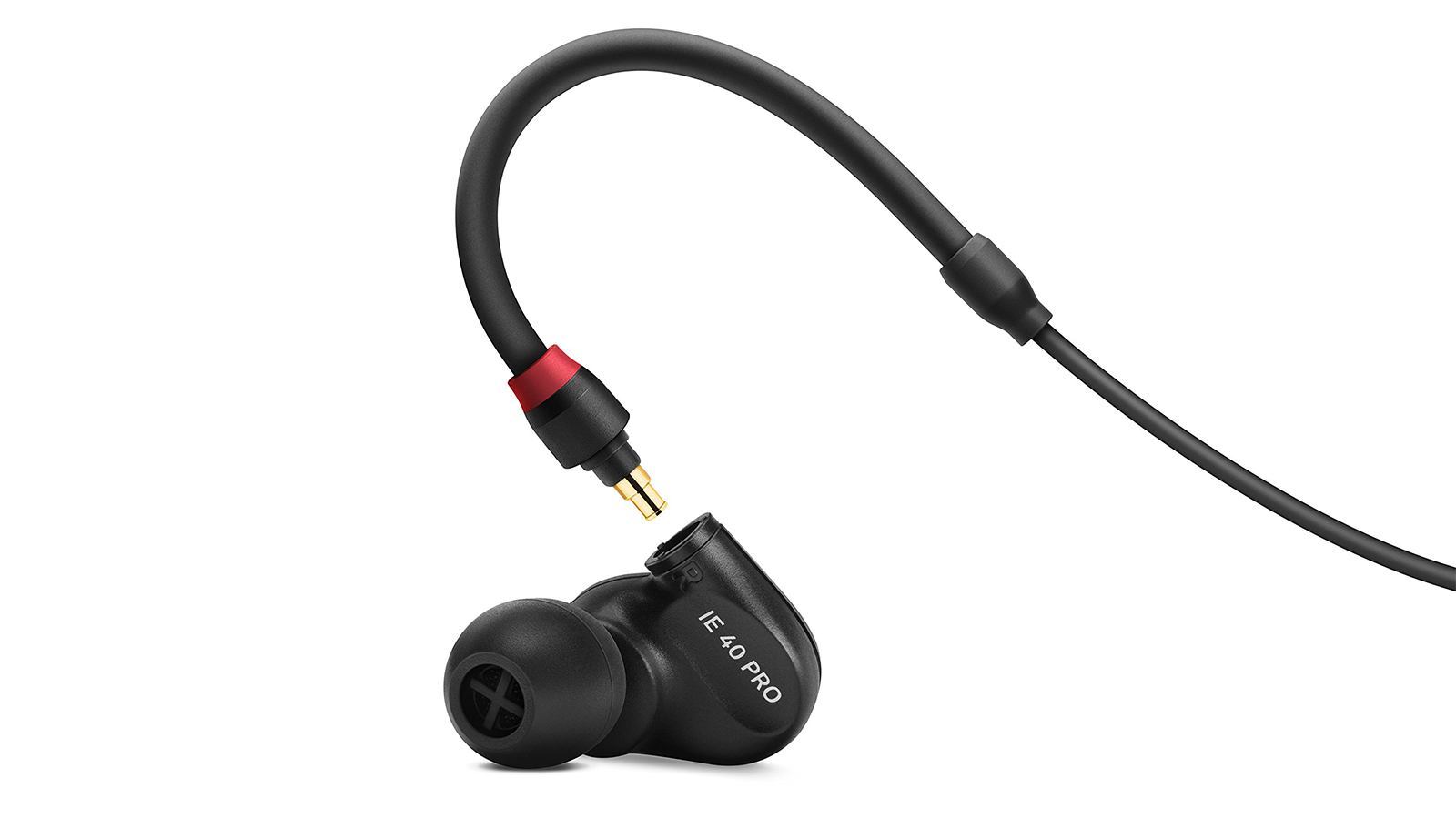
Specifications
Reasons to buy
Reasons to avoid
✅ Buy if comfort is key: A range of easily replaceable tips mean you'll get the ideal fit for your ears - important for long rehearsals or gigs.
❌ Avoid if you need a long cable: This is particularly important for drummers who need freedom of movement behind the kit.
Build quality ★★★★½
Comfort ★★★★½
Performance ★★★★☆
Overall ★★★★½
Overview: Sennheiser’s presence in this round-up should come as no surprise, so embedded is the brand in the world of all things listen-y. The IE 100 Pro is Sennheiser’s latest budget offering in the professional IEM space, a single-driver set that is more-than ready to go the distance with you.
Build quality: The Sennheiser IE 100 Pro is an understated set of in-ears. Though inexpensive, there’s a lot to like about how these have been put together – including the coaxial connectors that enable the cables to detach from each earbud between use. This is rarer than it ought to be in sub-$/£100 in-ears, and all the more refreshing to see. In terms of resilience, these certainly seem happy with bouncing back after some drops, dings and general rough-housing.
Comfort: In my opinion, this is where the Sennheiser IE 100 Pro truly shows its colours as a set of the best in-ear monitors. At this price, it’s not uncommon to find in-ears unbreathable and ultimately uncomfortable after short periods – but with the IE 100 Pro, the lightweight, small form-factor design makes them a lot easier to wear for long periods of time.
Performance: For this price, there is very little to complain about with the Sennheiser IE 100 Pro. It’s a single-driver set of in-ears with a decently wide frequency range, and a fairly flat response. There’s some decent low-end representation here, but it would be nice if they extended a little lower – something somewhat made-up for by their glassy treatment of high end. The earbuds are also quite effective at attenuating outside noise, with up to 26dB of attenuation.
Verdict: Truth be told, I’d buy these if they were twice the price. If I did, I might have more grounds to ask for improvements like an extended frequency range – but, as it stands, these might be the best-priced IEMs you can find, particularly if comfort ranks highly on your list of preferences.
Best mid-range option
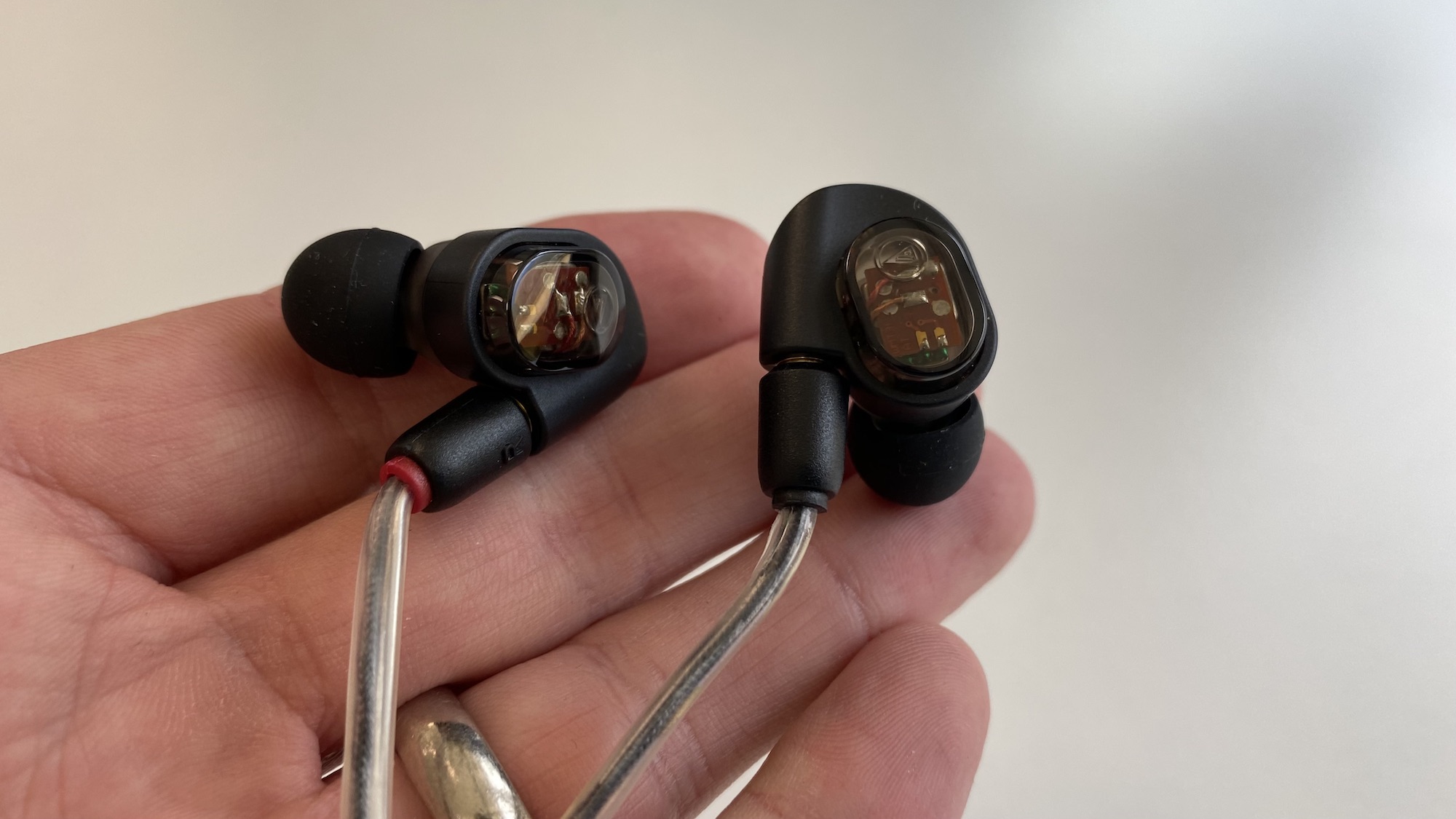
Specifications
Reasons to buy
Reasons to avoid
✅ Buy if you have a mid-range budget: You get a lot for your money with these IEMs, including wired memory cable loops for a secure fit around the ears.
❌ Avoid if you prefer a brighter sound: These in-ears definitely sit at the bassier end of the spectrum.
Build quality ★★★★☆
Comfort ★★★★½
Performance ★★★★½
Overall ★★★★½
Overview: Audio-Technica’s never far from a best-of list like this. It’s a brand synonymous with good design, whether in its range of consumer turntables and record-playing paraphernalia or in the recording world, with its microphones, headphones, and yes, in-ears. This is the ATH-E70, a mid-range set of IEMs with some real prospects for the developing musician.
Build quality: As with most things Audio-Technica, there is nothing to complain about here – apart from maybe the size, which (despite being a key USP for these powerful little earpieces) some may find on the smaller side. They’re solidly built, and Audio-Technica’s proprietary coaxial cable connectors do a fantastic job of securely mating buds to wires.
Comfort: Audio-Technica has achieved something brilliant with the ATH-E70; it’s rare to wear a set of in-ears that so readily melts into the sides of your face (in a good way, that is). Being light, comfortable and equipped with flexible memory cable that happily contours to the back of your ear, these in-ears become unusually easy to forget about. Four sizes of silicone tip (and an additional foam option) make it practically impossible for these not to meet your needs – and when they do, as an added bonus, they won’t go anywhere even with some serious jumping and bumping.
Performance: The ATH-E70’s earbuds are each equipped with three drivers, each of which concerns themselves with one third of the frequency spectrum. This sharing of duties makes for a surprisingly extensive response – particularly in the low end, where, despite a general lack of punch often suffered by in-ears, I found there to be some excellent overall representation.
The high end can be a little soft, but this matters little in all but the most sterile of studio atmospheres; for your needs, particularly on stage, these IEMs are the business. And actually, the fact that studio applications are being mentioned at all here is a credit to Audio-Technica’s driver engineering.
Verdict: Not everyone has hundreds to spend on the best in-ear monitors – and if they do, it’s often going towards some custom-moulded tips as opposed to the drivers ensconced within. The ATH-E70 is enough to make me pause on that particular train of thought, though – with great fit, great sound and great applications both in studio and on stage.

"A premium IEM. The comfort and sound quality make the E70s a serious rival to headphones for many situations."
Read more: Audio Technica ATH-E70 review
Best for mixing
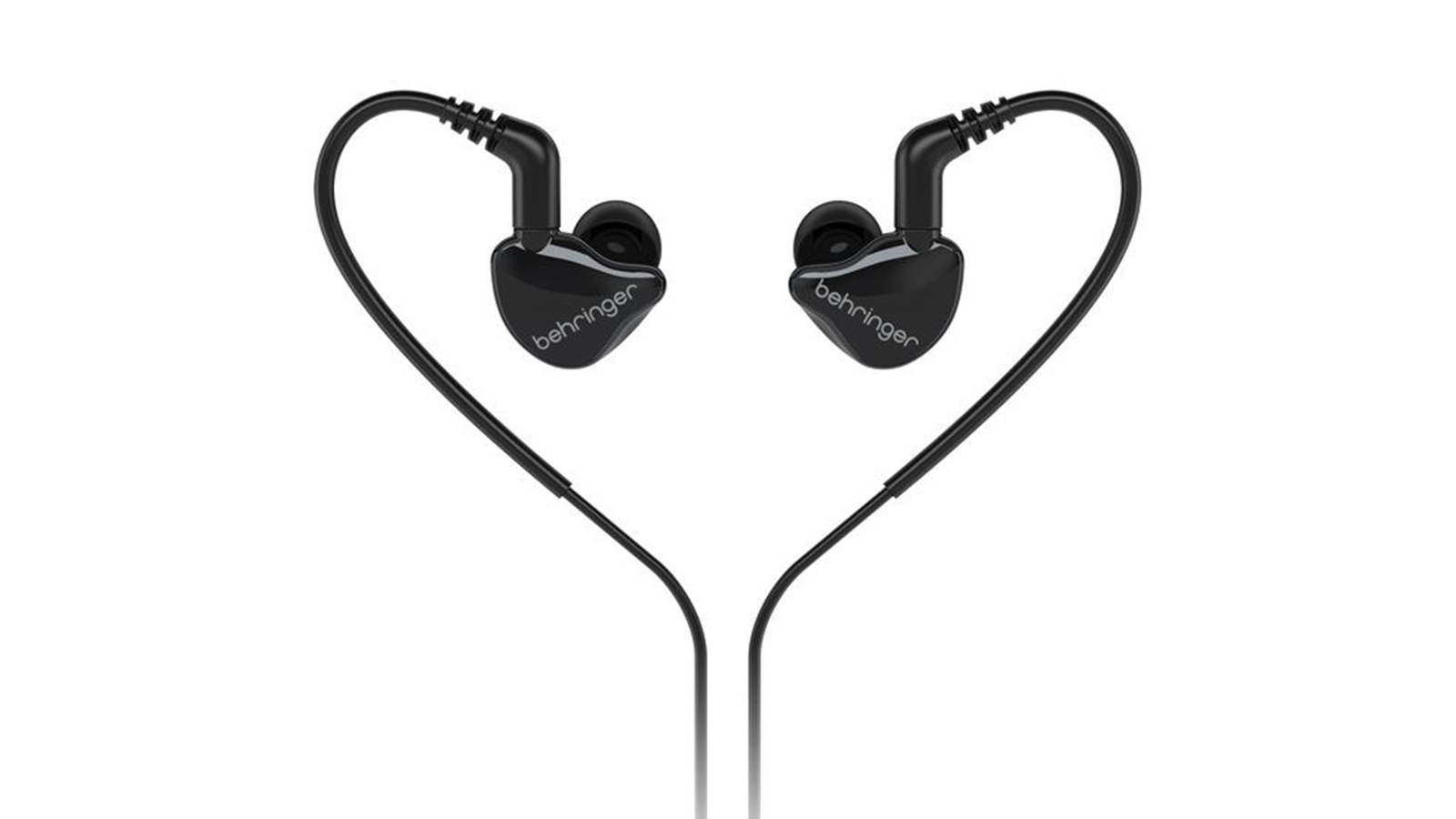
6. Beyerdynamic DT 70 IE
Our expert review:
Specifications
Reasons to buy
Reasons to avoid
✅ Buy if you want extra long range: The transmission range is 330 feet - you'll struggle to find a stage big enough to max that out.
❌ Avoid if you're buying it just for the in-ears themselves: As a package this is great, but there are better pair of in-ears out there.
Build quality ★★★★½
Comfort ★★★★½
Performance ★★★★½
Overall ★★★★½
Overview: Beyerdynamic is a force for good in aural tech, and already a major presence with respect to studio monitoring headphones. No surprise, then, that its first forays into the world of in-ear monitors are promisingly purpose-built tools for professional monitoring and critical listening. Where many in-ears are designed with performers firmly in mind, the DT 70 IE is designed for the engineer.
Build quality: These are some precisely-designed IEMs. Part of a series of four, all of which share the same essential form, the DT 70 IE is a well-made little pair with some comforting rigidity to its casing. The cabling is detachable and high-quality in its own right, and clever touches here and there make for an easy-to-use set of IEMs.
Comfort: Beyerdynamic has made sure its DT-series IEMs will fit the average ear, using MRI scans to image various ear canals and form a broad picture of the ideal generic-fit shell shape. With five different sizes of silicone ear tip and three sets of foam tips, there’s no chance these won’t fit comfortably within your own bonce. The thick cable over the ears is a good touch too, for security and comfort.
Performance: Though the Beyerdynamic DT 70 IE only features one driver per side, it is Beyerdynamic’s own Tesla.11 dynamic driver technology – and remarkably high-performing for its solitary station. The incredible breadth of the DT 70 IE’s frequency range is the first sign that these in-ears aren’t built like the rest.
The frequency response is perfectly sculpted for critical listening, with no undue preference given to mids and high-mids like other performance-centric models tend to give. The stellar 39dB of passive sound isolation also makes these uniquely excellent for the mix engineer wanting to focus on their desk output.
Verdict: These are some competitively-priced mid-range in-ear monitors, and an excellent set for the developing audio engineer to aim for. Despite the single driver per earbud, the performance on these is formidable – and separately, it’s just nice to see front-of-house get a proper look-in on a set of in-ears below $/£500.
Best sound quality
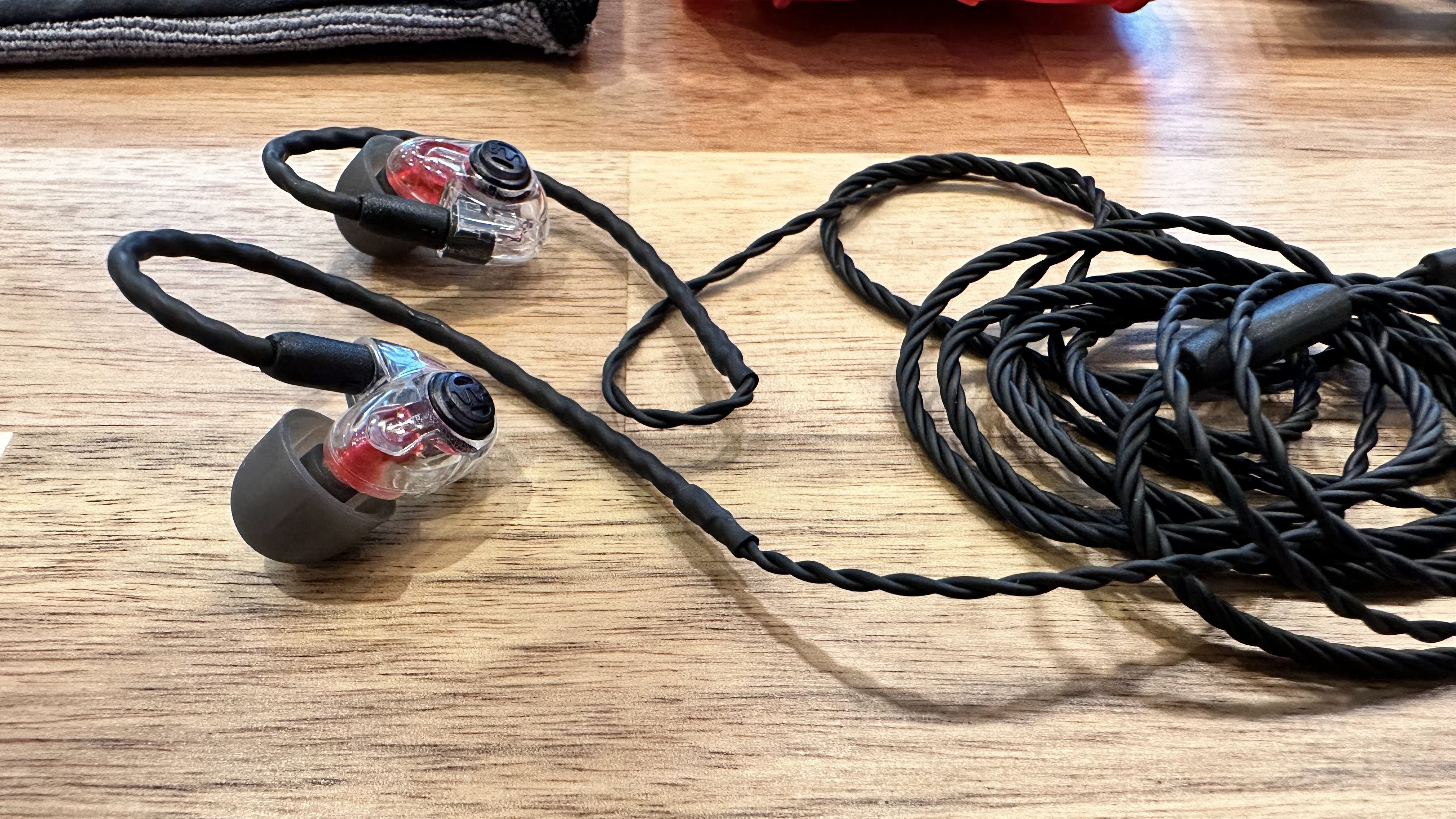
Specifications
Reasons to buy
Reasons to avoid
✅ Buy if you want multiple drivers: This pair features 6 drivers per bud for superb accuracy.
❌ Avoid if you want a better known brand: Westone Audio aren't as popular as Shure and Audio-Technica, but that makes them no less worthy of your consideration.
Build quality ★★★★½
Comfort ★★★★½
Performance ★★★★½
Overall ★★★★½
Overview: Westone Audio’s four-figure in-ear monitors might not be top of the list for a majority of musicians, but for professionals with the money to spend, it’s hard to find a better candidate. The Westone Audio Mach 60 IEMs are pro fare through and through, with a nuanced approach to sound reproduction and some smart ergonomic design for ease of long-term wear.
Build quality: In a word, the Mach 60 is understated. Though the earbud casings aren’t much to look at, they’re well-designed and sure to take a knock or two. Still, as an expensive set of IEMs, durability isn’t quite a top priority – nor will you be especially willing to risk the Mach 60 in particularly risky situations. Special mention is due, however, for the included hard case, which very much seems tough enough to stand up to life on the road.
Comfort: There isn’t a great deal to say about the Mach 60 when it comes to comfort. They are smartly designed and easy to install in each ear; with the right tip, you’re sure to get a great snug fit. I found them comfortable to wear for longer sessions, with particular thanks to the lightweight design of the buds (an engineering miracle, given the number of drivers crammed in there).
Performance: The Westone Audio Mach 60 boasts six drivers per earbud, each arranged in dual-driver format for low, mid and high frequencies respectively. This arrangement makes for an incredibly neutral reproduction of sound – something I’d go as far as to call ‘representative’.
This might not sound like the accolade that four-figure IEMs deserve, but it very much is; each driver has room to breathe, ensuring a far more realistic picture of what’s going on in front of a microphone or out of a desk.
Verdict: These IEMs certainly aren’t for everyone, but the sound they’re capable of reproducing makes them ideal for a core minority in music. These in-ears are just as at home in a live room as they are on a live tour – and, in fact, lend themselves better to the scrutinising ear than the gigging performer, by virtue of their incredible breadth, depth and accuracy.

"There’s a lot to like about the Westone Audio Mach 60 set. Comfort, accuracy and versatility combine to serve up a high performing overall package."
Read more: Westone Audio Mach 60 review
Best high-end
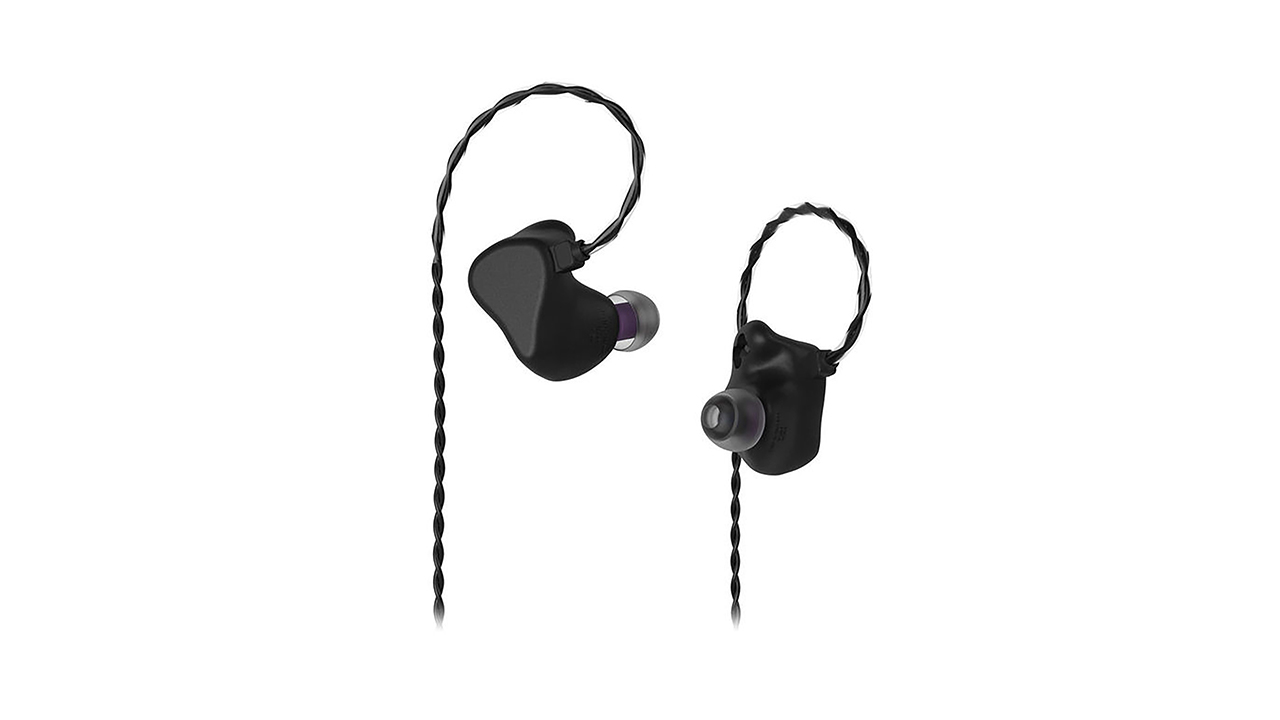
8. InEar ProPhile-8
Our expert review:
Specifications
Reasons to buy
Reasons to avoid
✅ Buy if you want uncompromising sound quality: Particularly if you're a touring musician, these in-ears are designed help you do your job better.
❌ Avoid if you want something basic and affordable: These are definitely over the top for most bedroom or hobby musicians.
Build quality ★★★★½
Comfort ★★★★★
Performance ★★★★½
Overall ★★★★½
Overview: Spending four figures on a set of in-ear monitors might be hard to justify for most musicians, but if anything was going to give you pause for thought, it would be the InEar ProPhile-8. These, as you'd expect for the price, are a completely different kettle of fish, designed for the touring musician rather than the home studio enthusiast. This set of IEMs is through-and-through professional – and if you’ve the budget, could be the last set of in-ears you ever need in your career.
Build quality: As you would hope for the outlay, the InEar ProPhile-8 is a well-engineered set of IEMs. Given the price, I wouldn’t want to trust them with an accidental stepping-on or fall from height – but feel secure enough that they wouldn’t mind some incidental scuffage. The textured matte shells feel nice in hand and in ear, and the overall design is very clever indeed.
Comfort: The cleverness of the InEar ProPhile-8’s design is most clearly represented by the form the earbuds take. InEar used hundreds of models of different ear canals to develop the ultimate generic-fit IEMs; you won’t find something more comfortable to wear outside of IEMs moulded specifically to your own ear canals. You could wear these for hours and still feel roughly like you’re wearing nothin’ at all (nothin’ at all, nothin’ at all…). Here, I’ll also note there’s an even smaller version of the same in-ears, for smaller ear canals; everyone can enjoy these!
Performance: A total of eight internal drivers per side, each paired as part of a four-way crossover system, provide what I can easily describe as pinnacle performance in this round-up. Each is carefully balanced, and the frequency response about as flat as you could ever ask from something so diminutive. Further, two rocker switches enable you to engage a 3dB low-end boost and 2dB high-end boost above 8kHz respectively – giving you access to four different sound profiles that cater to different listening scenarios. Finally, ambient noise absorption levels of around 26 dB guarantee superb on-and-off-stage isolation.
Verdict: This really is the top of the professional in-ear game. There may be ‘audiophile’ in-ears that command higher price points, but truthfully, you aren’t getting any more representative than these incredibly well-thought-out IEMs. If you have the money, don’t think twice.
Also tested
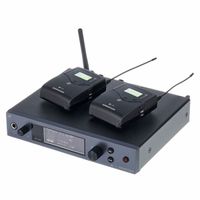
Sennheiser EW IEM G4 Twin
If you’re in the market for a complete wireless monitoring kit, the Sennheiser EW IEM G4 Twin is a fantastic place to start. It offers a solid connection reliably, with the excellent sound quality you'd associate with any Sennheiser product – and at a steal of a price.
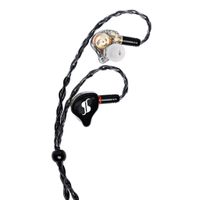
Stagg SPM-PRO
Stagg remains a solid prospect at the budget end of the price spectrum with these three-driver IEMs. A surprisingly wide frequency range bolsters the practicality of these great-fitting, great sounding in-ears.
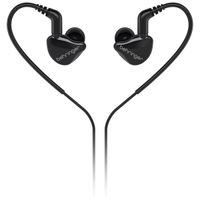
Behringer MO240-CK PRO
For something truly budget, there’s no more affordable prospect than Behringer. The MO240-CK PRO won’t win any awards for fidelity, but with a wide frequency range and competitive sound isolation, this is a highly viable budget pair of in-ears for those on the tightest of budgets.
How to choose the best in-ear monitors for you
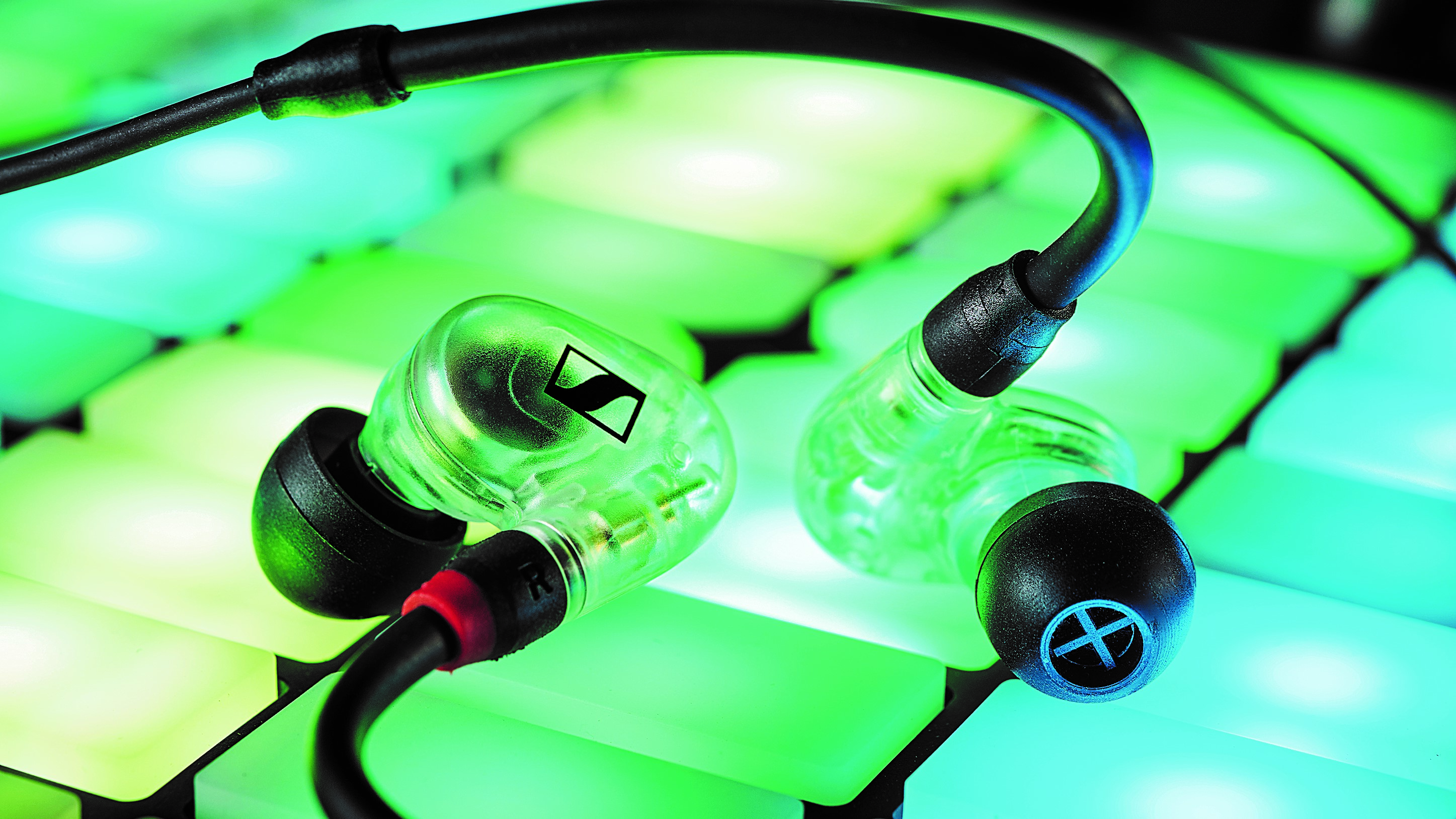
As you may have discerned from our well-stocked shortlist of the best in-ear monitors you can buy today, this is a wide and deep sub-section of the music industry marketplace – with a great many different technologies, form factors and fits to consider. Here are some key considerations you should make to help you work out exactly what you need:
1. Use cases
First off, what’s the reason you’re looking for in-ear monitors at all? Different people have different needs from their IEMs, whether they’re on stage, in rehearsals or behind a mixing desk. All IEMs are useful for basically the same reasons – delivering clear, isolated sound to your ears while protecting them from harmful volumes. But depending on your role, different IEMs can confer different benefits.
As a singer, you want IEMs to give you a clear representation not just of what your band or backing track sounds like, but also of what you yourself sound like – while giving you enough sound isolation to lock into your performance. As a drummer, clarity may be less important to you than outright sound isolation – to protect your ears from the volume of your own kit, while still enabling you to follow your band. Live sound engineers, meanwhile, need remarkable fidelity in order to be able to properly parse the mix decisions they’re making in the room.
2. Fit
Comfort is key when it comes to in-ears. After all, they’re meant to go in your ears – and stay there too, often for long periods of time. A number of things impact the fit of a pair of IEMs, from the distribution of weight inside each earbud to the quality of the material that constitutes the tip. The most comfortable IEMs money can buy are custom-moulded to the shape of your ear – which is what most festival-headlining acts stump for – but this isn’t always the most accessible option for the average gigging musician, live producer or front-of-house engineer.
The off-the-shelf options covered above may not be as individually snug as a set of custom in-ears can be, but they can get 95% of the way there – depending on what works for you. This is a hard factor to test for, particularly when IEMs aren’t really something you can try before you buy, but you can still benefit from reading reviews and looking for positive statements about long-term comfort.
3. Sound
IEMs don’t just sit in your ear to block sound and look (questionably) pretty while doing so. They’re there to deliver you sound, as well – and need to be pretty darn good at doing so to be worth your investment. Everything featured in my round-up enjoys a base level of quality, but naturally, you’ll see considerable improvements in performance commensurate to increases in how much you’re willing to spend.
For instance, in-ears with multiple drivers are better-equipped to deliver a flat frequency response, as each driver can focus on a specific frequency band. Cheaper in-ears often have just the one driver per earbud, but can still do a decent job; with more drivers, performance at the extremes of the audible frequency spectrum tends to improve.
4. Build quality
No one wants to spend hard-earned money on some music tech that’s destined to fall apart in a matter of months. To that end, build quality is an important consideration for everyone looking to buy a set of in-ear monitors. However, it still matters more to some than others. if you’re touring, for instance, you want a bombproof pair that will reliably go the distance without crapping out. If you tour less often and have a lower budget, maybe it makes more sense to buy a budget option from a reliable brand; an option you’re not too fussed about finding the money to replace when they eventually fail.
5. Budget
On this point, budget is ultimately the factor which will guide most people’s decisions when picking their next set of IEMs. If you’ve got the budget for an ideal set of quality in-ears, great! If you’re a little harder-up, you’ll have no issue picking up a great pair for a low price – but you will likely find that such IEMs are deficient in at least one of the above factors. The question then becomes: what’s worth more to you, if money is an object?
FAQs
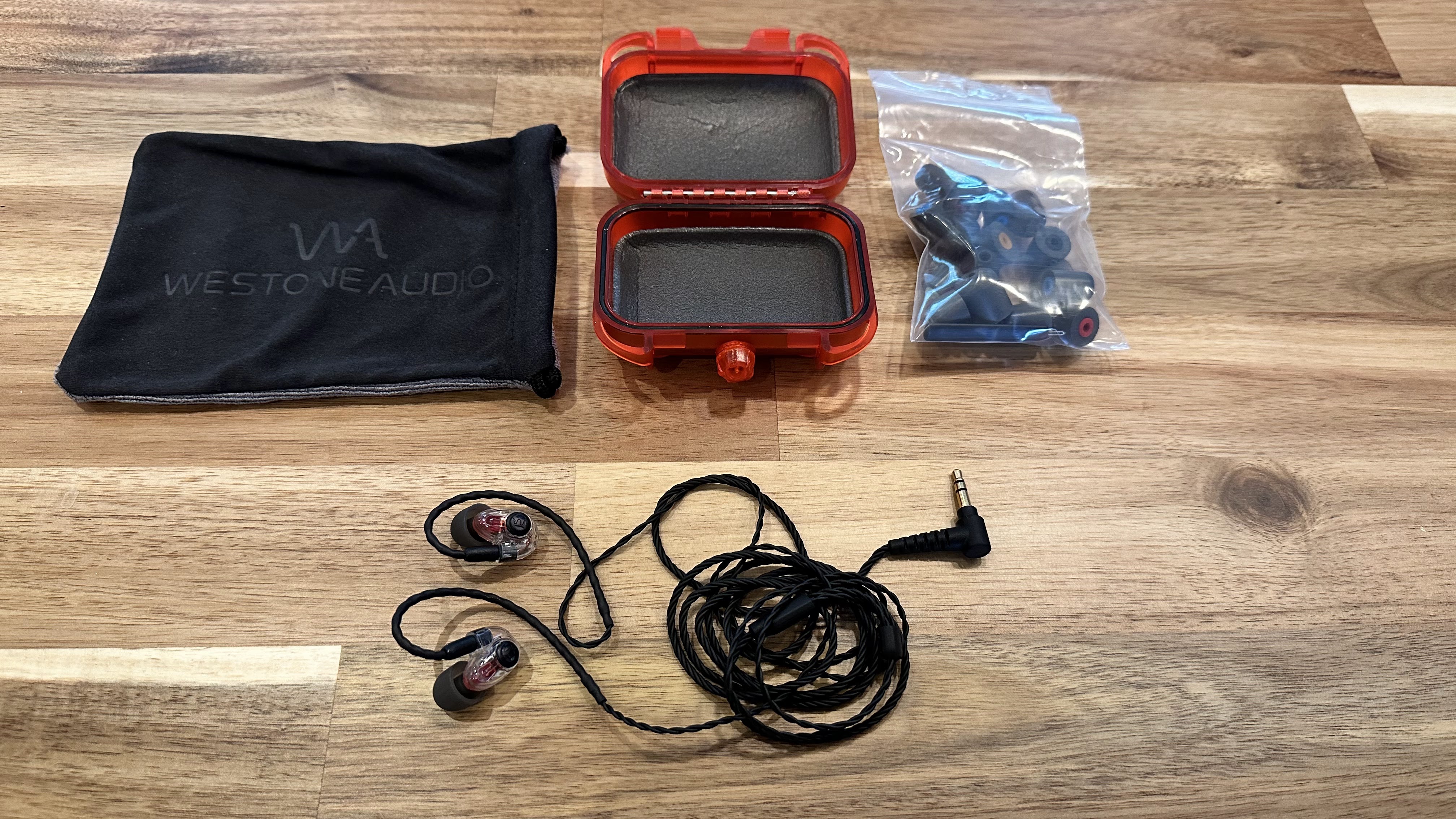
What are in-ear monitors (IEMs)?
In-ear monitors, or IEMs, are intra-aural hearing devices that deliver audio to your ears while attenuating the sound of the world around you. They work similarly to wired earbuds; they are (usually) passive devices, with drivers that receive electrical audio signals from a source and convert them to audio in your ears. However, they differ from consumer earbuds in that they are designed with professional applications in mind – whether aiming for a flat, neutral frequency response to aid critical listening, or paying close attention to safe attenuation of loud volumes often experienced in live performance environments.
Why do you need in-ear monitors?
In-ear monitors are hugely useful in a wide variety of environments – but perhaps best-known for the support they provide vocalists in live performance contexts. As a singer, in-ear monitors are a god-send for keeping in touch with your own performance, for clearly hearing the music you’re singing along to and for keeping track of information either baked into backing tracks or relayed by your sound engineer.
It’s not just singers that benefit from IEMs, though. For other musicians, IEMs can be a far more reliable source of information than the usual monitor wedge – which has to compete with on-stage audio sources and the front-of-house PA, all without feeding back and ruining everything for everyone.
Every guitarist reading this knows the pain of asking for “more of me please” in the monitors, and resignedly saying “yeah that’s great thanks” after hearing absolutely no change at all. With IEMs, you can either take a direct feed from your pedalboard to hear yourself absolutely, or receive a monitor mix to your ears for complete control.
Drummers have it harder still, for reasons obvious to perhaps everyone reading this. Not only do monitor wedges often fail to peek over the irrepressible volume of the kit, but drummers often risk their own hearing with a full-blast monitor in one ear and an aircraft-volume snare drum in the other. IEMs are an opportunity for drummers to hear what’s going on at a safe volume, and also block out the unsafe stuff in the process.
You don’t have to be on the stage to benefit from IEMs either. Live sound engineers, stage managers, monitor engineers, guitar techs – all can do their work both better and safer with a direct line to stage sound, monitor mixes and talkback mics, and with safe isolation from the damaging volumes on-stage and out front. Mix engineers can get an especial edge over others here too, if they have a pair of IEMs capable of delivering a flat, full-spectrum frequency response. It’s a similar story for DJs, electronic artists and one-man-bands!
There are so many ways a set of the best in-ear monitors can be game-changing for a given Person In Music™. Whatever it is you do, if you do it on stage, there’s a high chance that in-ears will make a major improvement to your practice. And we’ve not even touched the studio applications of in-ears either!
Do I need moulded in-ear monitors?
The in-ear monitors you can readily buy from music shop shelves or online listings are generic-fit in-ears. Like most off-the-shelf earplugs, they are designed from the average ear – which means some small concessions are made, either for efficacy of sound isolation or long-term comfort. For the platonic ideal set of in-ear monitors, you would want them to perfectly fit the unique contours of your own ear cavities, hence perfectly separating within from without.
These types of in-ear monitors do exist! They’re called moulded in-ears, and they are made-to-measure from ear impressions taken by a licensed audiologist. Such in-ears may be ideal, but they are also costly. Not only do you have to factor in the cost of ear impressions being taken, and the higher cost of having custom in-ears manufactured, but you may also have to contend with the higher cost of the electronics involved. After all, if you’re going to such lengths as getting custom moulds of your ears, why would you settle for sub-par intra-aural sound?
My round-up of the best in-ear monitors does not include any custom moulded products, simply for the fact that these are often inaccessible to the grassroots or up-and-coming musician; not only that, but they are often unnecessary. Generic-fit in-ear monitors get you 95% of the way there, and can do so with some excellent specs too; some are even the tech-y basis around which moulded ear-tips are fashioned.
Whichever way you slice it, the IEMs reviewed above are the cream of the crop, and also used by innumerable high-profile professionals in music. In short – moulded in-ears are the theoretical pinnacle of in-ear tech, but you don’t need moulded in-ears to get pro results.
What makes a good set of in-ear monitors?
The attributes that constitute the best in-ear monitors will change from use case to use case, but there are some broadly-applicable specs to bear in mind. One of the most important attributes a pair of IEMs can possess, for instance, is comfort.
Whether you’re a touring musician soundchecking and performing for hours a day, or a live mix engineer doing sound for a venue five nights out of the week, you can guarantee getting deeply acquainted with your in-ears in short order. The last thing you want is a pair that irritates you within minutes. Granted, this is a hard thing to select for when buying, since you won’t be able to try before you buy – but it’s a good thing to know when starting to do some research into a pair that’s taken your interest.
Outside of this, the key aspects that decide whether a pair of in-ear monitors are worth the money are twofold – sound delivery, and sound isolation. Fidelity isn’t as important for some as it might be for others, but everyone deserves a clear and natural sound in their ears.
IEMs with multiple drivers per earbud are better-equipped to handle audio across the frequency spectrum, as different drivers can be tuned to handle different frequency bands. For those that would benefit from higher-fidelity – be they studio engineers or live sound engineers – a flat frequency response is ideal.
As for sound isolation, a good set of in-ear monitors is capable of safely blocking the louder excesses of a studio or stage environment from reaching your sensitive eardrums. Different IEMs will offer different levels of attenuation; the closer you are to an especially loud sound source, the more attenuation you’re likely to want. Drummers will benefit the most from IEMs capable of blocking the most sound, purely for the extra protection they need from the high transient volumes at play.
How do I use in-ear monitors?
In-ear monitors are, for live musicians, effectively a stand-in for monitor wedges. They can also be used with backing tracks, to enable bands with more complicated arrangements to follow transitions and changes – or just keep to a metronome, without sound bleeding out to the audience. There are various ways to consider setting up in-ears as a musician, but three key options to choose between.
The first is to use in-ears as an extension of your own on-stage setup. If you run backing tracks from a laptop via an audio interface, for instance, you could use a headphone amplifier to split the headphone output signal, and send different outputs to your band’s in-ears. If you’re wanting to hear your own instrument exclusively, you could add a headphone amp directly to your effects chain before it reaches an amplifier or DI box, hence giving yourself a direct line to your own sound.
Bands with a little more in the way of production budget may even have their own stage monitoring rig. This is a multi-stage system that requires a bit of setting up, but which also makes stage plotting far easier as a touring project. Every microphone or DI signal would first go to a patchbay in your rig, with throughputs for connecting to the venue’s mixing desk.
The signal would be split at the patchbay, and either delivered to a monitor mix engineer’s rig or simply to an audio interface, where signals can be independently mixed specifically for monitoring. The resulting mixes can then be delivered, via a headphone amplifier, to individual sets of in-ear monitors.
If you have the money, you may even have a wireless transmission system, so you can plug your IEMs into a receiver tucked away on your person somewhere. Such a system is beneficial for controlling your own IEM’s volume, as you can simply adjust how loud your mix is at the receiver.
There are many different ways to use in-ear monitors, and even the pros at the top of their game will have different kinds of rig or system that work for their unique needs. Truthfully, this topic is far larger than the space I can give it here – and, depending on your readiness to delve into technicalities, a playground of audio-engineering potential.
How do I use in-ear monitors as a singer?
For smaller and grassroots artists, it’s often only the singer that uses in-ear monitors. These in-ears allow the vocalist to more accurately hear their own voice against loud stage sound, meaning a more controlled vocal performance. For singers, using in-ear monitors from gig to gig could be as simple as asking the live sound engineer for a separate vocal monitor to be sent up to the stage via DI box. This way, you could receive a unique mix in your ears by plugging into the DI via an aux extender cable – and still use the wedge monitors for a fuller band mix, if you wanted.
If your band uses a backing track from a laptop, you could utilise your audio interface as your monitor mix. To do this, you would split your vocal signal on-stage with a DI box; one signal would go to the FOH desk, and another would go to your computer. Your IEMs would be plugged into the interface’s headphone output, so you could hear both yourself and your backing track. You could even retain control of your ideal vocal mix on stage, by having your effects set on a vocal channel in your DAW, and sending the output of your interface to the desk.
Again, there are many more ways to skin this particular cat than I have room for here. Even if you’re on a budget, some wireless transmission systems are forgivingly cheap – and could be the path of least resistance to an easily set-up vocal monitor without trailing cables or potential points of failure. Whatever works best for you, a little research will go a long, long way.
Why should I use IEMs instead of wired earbuds?
We’ve already established that there are some fundamental similarities between in-ear monitors and wired earbuds or earphones – so why should you spend more money on a set of in-ear monitors if wired earbuds could provide the same functionality? Well, the short answer is that wired earbuds actually don’t provide the same functionality at all.
Wired earbuds and in-ear monitors are both wired, passive audio devices that use drivers to convert electrical signals into audio, yes. But in-ear monitors are designed specifically with a clear, flat frequency response for as neutral a transmission of audio as possible – where wired earbuds are often designed to flatter the music you’re hearing, whether by designing for a big low-end hump for more gratifying bass, or sculpting the high-mids for silky vocals. Wired earbuds aren’t telling ‘the truth’ about the sound you receive, which could cause problems on-stage or behind a mixing desk.
Another key difference is that in-ear monitors are also designed to properly isolate your ears from outside noises, in order to protect you from loud transient volumes and ensure you can properly hear the mix you’re being delivered. Consumer earbuds naturally have some isolation from the outside world, but aren’t designed with professional music-making applications in mind. As such, you could inadvertently put yourself in danger relying on wired earbuds for hearing protection.
What are the risks of not using IEMs?
Besides the risk of doing a poorer job without proper control of your monitor mix, the key risk you face not using in-ear monitors is tinnitus! Everyone working in the live music industry should be using some form of hearing protection, whether earplugs for musicians that offer safe attenuation of high volumes without massively impacting sound, or in-ear monitors that give you more control over the sounds you receive.
Without protection, the high volumes on stage are sure to cause discomfort or even hearing damage in the short to medium term – and guaranteed to cause hearing damage in the long term. Even if you aren’t playing at blisteringly loud volumes, prolonged and unprotected exposure to volumes at or above 85dB (roughly the volume as rush hour traffic, or a running lawnmower) is enough to cause damage and hearing loss over time. Wearing earplugs is a great start, but in-ear monitors are ideal for blocking harmful stage volumes and delivering manageable intra-aural sound.
How do I maintain my IEMs?
In-ear monitors are easy enough to maintain, particularly if they’re built to last! The main concern you have is with keeping them clean; the ear isn’t the most spotless of places to put something, after all.
Practically every pair of generic-fit in-ear monitors you can buy will have removable silicone or thermoplastic ear-tips, which you can remove and clean in a solution of warm water and dish soap – or diluted isopropyl alcohol. A cotton swab works wonders on the driver ports of each bud, and isopropyl alcohol can often be used safely on the body of each bud.
Manufacturer’s instructions reign supreme, though, so be sure to check these for whichever set you’ve bought!
Key terms
Unsure about the meaning of some of the terms used in this guide? Here's a quick explainer of the most IEM phrases you'll come across:
Active
Active audio technology is technology that requires additional power to work, beyond the power inherent to the electrical audio signals it may receive. The vast majority of IEMs are passive, like wired earphones or headphones; some, though, require external power to offer such techy bells and whistles as active noise cancelling (ANC) or on-board sound profiling.
Attenuation
Attenuation refers to the reduction in sound level of an incoming sound. This is achieved passively by in-ear monitors, which are often rated to a certain level of attenuation – measured in decibels.
dB
The decibel, given as dB, is a logarithmic unit of measurement used for the intensity of sound waves. For every three decibels, the intensity of a sound doubles. dB is used both to measure sound levels and to describe the level of attenuation a set of in-ear monitors or earplugs may be capable of.
Driver
The driver is the element in an earbud that converts electrical signals into acoustic signals. There are various designs of driver that achieve different results; in-ear monitors will frequently use multiple drivers per earbud, in order to better handle audio from across the frequency spectrum.
Ear tips
Ear tips are the silicone, foam or thermoplastic attachments that slip over the port of an in-ear monitor’s earbud, and which ensure a secure fit in your ear.
Ergonomic
Ergonomics refers to how well something is designed for the human body. An ergonomic chair is well-sized for leg placement and posture, hence less likely to cause you back pain over time; similarly, in-ear monitors tend to be ergonomic for the way they’re designed to nestle in your ear. The best in-ear monitors are well-designed with ergonomics in mind, and can be worn for extended periods of time with minimal discomfort.
Frequency response
Frequency response, in the context of in-ear monitors, refers to how a set of in-ears interprets the audio signals it receives across the frequency spectrum. The ideal in-ears would possess a completely flat frequency response, enabling the neutral transmission of a signal without unwanted colouration or alteration; this would enable you to hear exactly how a sound is being reproduced, and make adjustments accordingly.
Front of house (FOH)
Front of house, or FOH, refers to the area in front of the stage – where the audience go. A front-of-house mix would be the sound that ultimately comes out of the PA system, to be heard by the crowd; a front-of-house engineer would be the mix engineer responsible for said sound.
Intra-aural
Intra-aural is a technical way of saying “in the ear”; in-ear monitors are intra-aural because they sit in the ear and deliver sound directly through the ear canal. Headphones would be ‘circum-aural’, because the earcups surround the ear, and sound is delivered from outside.
Isolation
Isolation, in the context of in-ears, refers to the isolation of your ears from the sounds of the outside world. In order to hear the output of your in-ears clearly, you want to have good isolation from stage volumes. See attenuation.
Monitor wedge
Monitor wedges, or ‘monitors’ for short, are speakers used on stage to deliver sound to musicians playing live. Different monitor mixes can be sent to each musician via these speakers, enabling them to hear what they and their bandmates are playing – as well as any unamplified elements that may be sent to the desk via DI, or otherwise exist in a backing track.
Monitor mix
A monitor mix is a separate mix from what audiences hear out of the front-of-house PA system, designed to help musicians on-stage. During a soundcheck before a gig, the live sound engineer (or a dedicated monitor mix engineer) will ask each musician what they’d like to hear in their monitor wedges or in-ears; they will then create a unique mix and send it to each musician, so they can hear what they need to hear to perform well.
Moulded
Moulded in-ear monitors are custom-fit apparatus, wherein the eartips are manufactured to match precise impressions taken of the inside of your ear. Moulded IEMs have a better, more snug fit than off-the-shelf, universal-fit IEMs, and hence more reliable sound isolation too. However, these benefits come at a considerable cost, and can make replacement expensive too.
Passive
Passive audio technology is technology that works without the need for external power. An electric guitar is passive, as the electrical signals it produces are induced via the movement of metal strings over magnetic pickups. The vast majority of IEMs you can buy are passive, too; the drivers they contain receive an amplified electrical signal from a wireless receiver or headphone amplifier, which is strong enough to excite them into reproducing the same signal acoustically in your ear.
Port
The port is the opening through which sound is delivered on a given in-ear monitor’s earbud. It is often covered with mesh or fabric to prevent ingress of wax, oils and sweat from the ear.
Wireless transmitter/receiver
Wireless transmission systems are as they sound; they transmit audio over high-frequency radio waves to wireless receivers. These are frequently used in musicians’ monitor rigs, to enable the wireless communication of monitor mixes, band leader instructions and other information. In-ear monitors would be plugged into a wireless receiver pack, clipped to your person.
How we test in-ear monitors

There are several factors we look at when testing in-ear monitors (IEMs), the most important being quality, comfort and isolation. This is similar to how we test regular studio headphones, but as IEMs are most often used on stage, isolation is perhaps a more notable consideration – you want to hear your own performance without being drowned out by the rest of the band playing around you. Obviously when testing IEMs, it's not always practical to set up an entire band onstage, but we do test isolation claims by using the IEMs in a variety of situations, both in the studio and on stage.
While IEMs are aimed at live musicians, they can also be used in the studio and some producers prefer their design over more traditional on-ear headphones that can be less comfortable. Isolation is still important here but perhaps more so is comfort. Do the IEMs sit well in your ears? Are they almost 'invisible' when wearing them as some regular studio cans can feel?
Sound quality is, of course, paramount and the more expensive models will offer more drivers and therefore better frequency response specs. We test IEMs against a range of well-known recorded music standards, and against other reference sets of in-ear monitors to test their sound. It's also important that they deliver this quality at lower volume levels as you don't want to have to crank up the output – part of the reason for choosing IEMs in the first place is to save your ears. Isolation will again play a big part here as you won't have to push the volume as hard if you are not getting so much external interference.
Finally, design quality and price are considerations plus, of course, wireless performance (unless they are wired!) in terms of operating distance, number of channels and stability and the associated battery lifetime compared to quoted statistics.
Read more about how we test music making gear and services at MusicRadar.
Why trust us?
☑️ MusicRadar established 2007
☑️ Over 5,000 reviews on-site
☑️ 30+ in-ears reviewed
MusicRadar first launched in 2007 and has been an authority on electronic drums ever since, rigorously testing the majority of key launches since day one. The site is run by a diverse team of passionate musicians who live to gig, record and jam, alongside a core group of trusted specialist freelance writers. We understands what players need, because we’re players ourselves, and we test from this perspective.
Our team have been testing music gear for 17+ years, constantly refining our methodology, delving deeper into products and drawing on our experience of what has come before to understand today’s products better than anyone.
Latest updates
19/11/25: We've made some light tweaks to the page, mostly to improve readability and navigation around the content. Elswhere we've added star ratings boxes to each guide entry so it's easier to see what we've rated each pair of in-ears across categories including build quality, comfort and performance.
07/07/25: This guide has had a top-to-bottom overhaul. Our experts have added a lot more depth and insight to each product entry and buying advice and FAQs that leave no stone unturned when helping you find the right set of in-ears for you. Finally, we've now included a 'key terms' section which sheds light on all the key words and phrases you'll hear when reading up on in-ears. We've added two new products to this guide: the Sennheiser IE 40 Pros have been replaced by the Sennheiser IE 100 Pro; the Sennheiser EW IEM has been replaced by the Beyerdynamic DT 70 IE as a great option for mixing and front of house applications.
Read more:
MusicRadar's got your back
- Try the best home studio mixers for all budgets
- Explore the best studio monitors available today
Want all the hottest music and gear news, reviews, deals, features and more, direct to your inbox? Sign up here.
Chris Corfield is a journalist with over 12 years of experience writing for some of the music world's biggest brands including Orange Amplification, MusicRadar, Guitar World, Total Guitar and Dawsons Music. Chris loves getting nerdy about everything from guitar and bass gear, to synths, microphones, DJ gear and music production hardware.
- James Farmer
- Andy Jones
- Matt McCrackenJunior Deals Writer